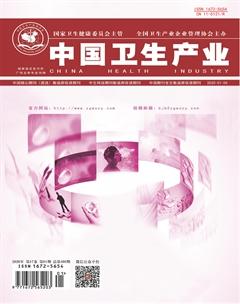分析走动式管理在儿科门诊注射室护理质量管理中的应用效果
张娟

[摘要] 目的 在儿科门诊注射室当中实施走动式管理模式,分析其对护理质量的影响。方法 选择2018年1—12月在该院接受儿科门诊注射室治疗的小儿患者120例纳入研究,按照其接受的儿科门诊注射室管理模式的差异分为对照组和研究组,对照组接受的管理模式为常规性质的,研究组则在常规护理的基础上加以走动式管理,将两组在完成诊治后护理满意度进行调查,并评估两组护理质量(医院沟通、技术操作、服务态度、医院环境)。结果 调查以及评估结果表示,研究组护理满意度优于对照组,且研究组在各项护理质量项目中得分高于对照组(P<0.05)。结论 针对儿科门诊注射室的小儿患者可以实施走动式管理模式,其有利于优化整体服务质量,为小儿患者提供全面的管理,加快诊疗效率,提升小儿家属对医院服务的满意度。
[关键词] 走动式管理;儿科门诊注射室;病区;护理质量;护理管理
[中图分类号] R47 [文献标识码] A [文章编号] 1672-5654(2020)01(a)-0039-03
[Abstract] Objective To implement a walking management mode in the injection room of a pediatric clinic and analyze its impact on the quality of care. Methods A total of 120 pediatric patients who were treated in our hospital's pediatric outpatient injection room during the period from January to December 2018 were selected. All of them were included in the study and managed according to the pediatric outpatient injection room they received. The differences in the models are divided into the control group and the research group. The management mode accepted by the control group was of a conventional nature. The research group was based on routine care added ambulatory management. The satisfaction of the two groups after the diagnosis and treatment was investigated, and the quality of care between the two groups (hospital communication, technical operations, service attitude, hospital environment) was assessed. Results The survey and evaluation results showed that the nursing satisfaction of the study group was better than that of the control group, and the study group scored higher than the control group in various nursing quality items(P<0.05). Conclusion The pediatric patients in the pediatric outpatient injection room can implement the ambulatory management mode, which is conducive to optimizing the overall service quality, providing comprehensive management for pediatric patients, accelerating the efficiency of diagnosis and treatment, and improving the satisfaction of pediatric families to hospital services.
[Key words] Walking management; Pediatric outpatient injection room; Ward; Nursing quality; Nursing management
兒科门诊注射室中的小儿患者大都是发病突然、病情发展迅速、病情变化多样等,需要接受及时的诊治,但是儿科门诊注射室患儿数量比较多,且家属因为患儿的病情存在焦虑的心理,对就诊过程中的护理具有较高要求,医院针对儿科门诊注射室实施管理措施存在一定的难度。以往对儿科门诊注射室实施的常规护理管理措施往往达不到患儿家属的要求[1],无法提高诊疗效率,容易引起护患纠纷,因此临床针对儿科门诊注射室的特点,近几年逐渐应用走动式管理模式,为儿科门诊注射室小儿患者提供全面护理,提高护理质量。该研究选择2018年1—12月在该院接受儿科门诊注射室的小儿患者120例为研究对象评价该院儿科门诊注射室实施走动式管理措施的效果,现报道如下。
1 资料与方法
1.1 一般资料
该研究取选择在该院儿科门诊注射室接受治疗的小儿患者共120例,将其全部纳入研究当中,在纳入研究之前所有患儿家属对该研究知情并同意参与其中,均为第1次到儿科门诊注射室就诊,按照其接受的儿科门诊注射室管理模式的差异分为对照组和研究组。对照组:男患儿32例、女患儿28例;年龄分布区间为1~10岁,年龄中值为(5.2±1.6)岁;研究组:男患儿34例、女患儿26例;年龄分布区间为1~11岁,年龄中值为(5.8±1.2)岁。将两组患儿年龄、性别进行比较差异无统计学意义(P>0.05)。

